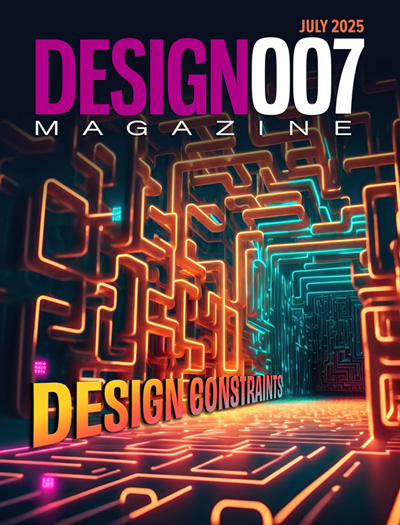-

- News
- Books
Featured Books
- design007 Magazine
Latest Issues
Current Issue
Signal Integrity
If you don’t have signal integrity problems now, you will eventually. This month, our expert contributors share a variety of SI techniques that can help designers avoid ground bounce, crosstalk, parasitic issues, and much more.

Proper Floor Planning
Floor planning decisions can make or break performance, manufacturability, and timelines. This month’s contributors weigh in with their best practices for proper floor planning and specific strategies to get it right.

Showing Some Constraint
A strong design constraint strategy carefully balances a wide range of electrical and manufacturing trade-offs. This month, we explore the key requirements, common challenges, and best practices behind building an effective constraint strategy.
- Articles
- Columns
- Links
- Media kit
||| MENU - design007 Magazine
Lightning Speed Laminates: Why Do Different Test Methods Yield Different Electrical Values?
January 20, 2016 | John Coonrod, Rogers CorporationEstimated reading time: 2 minutes
A variety of different test methods may be used for any one electrical concern. This article will discuss the issues related to determining the dielectric constant (Dk) and dissipation factor (Df or Tan-Delta). On a data sheet, a designer may see a Dk value for a material to be 3.5, as an example. Once the designer buys the material and performs necessary evaluations, it may be found that the Dk of the material is 3.8. In some applications this difference in Dk is probably not meaningful; however, for many RF and high-speed digital applications, this difference could be very significant. What is really interesting about this example is that the two Dk values may both be correct, depending on the test methods used.
Most laminates used in the PCB industry are anisotropic and this means that the electrical properties are not the same on all three axes of the material. Typically the thickness (z-axis) of the material will have a different Dk value than the x or y axes of the material. The reasons for this depend on what type of material is being considered.
The laminates used in the PCB industry are typically woven-glass reinforced, however there are notable exceptions. The glass reinforcement layer typically has a different Dk and Df than does the raw substrate of the laminate. The standard E-glass most often used in PCB laminates has a typical Dk value of about 6 and a dissipation factor of around 0.004. The common FR-4 laminates use relatively simple resin systems and the resin itself has a Dk that is around 3 and a Df of about 0.03. Different ratios of resin to glass will cause the laminate to have a Dk that is somewhere between the value of the resin and that of the glass. However, the glass-resin ratio impact on Dk is usually considered when evaluating the material through the thickness axis and if the x- or y-axis is evaluated, the Dk value may be very different than the z-axis result.
A large number of test methods are available to evaluate materials for Dk and Df. The methods that are most often used in the PCB laminate industry for making these measurements are typically tailored to evaluating materials in very large volume. Because of this issue, these test methods need to determine Dk and Df relatively fast, have good repeatability, and be used for quality control. A common test method used is the clamped stripline resonator, where a clamping fixture is used to form a stripline structure; the layer structure of a stripline is ground-signal-ground. This test method determines the Dk and Df of the material in the clamped fixture and more specifically, it is reporting these values related to the thickness axis of the material.
To read this entire article, which appeared in the December 2015 issue of The PCB Design Magazine, click here.
Testimonial
"We’re proud to call I-Connect007 a trusted partner. Their innovative approach and industry insight made our podcast collaboration a success by connecting us with the right audience and delivering real results."
Julia McCaffrey - NCAB GroupSuggested Items
Smart Eye Receives Milestone AIS Order from Fleet Safety Company Optix
09/11/2025 | Smart EyeSmart Eye, a global leader in Human Insight AI and Driver Monitoring Systems (DMS), announced a milestone order for its AIS system from Optix, a global provider of fleet management solutions. Initially, in 2025, 4,000 commercial vehicles will be equipped with Smart Eye’s technology, marking the first wave of deployments globally.
Datest Unveils Viscom iX7059 XL 3D CT AXI System
08/25/2025 | DatestDatest, a trusted leader in advanced testing, engineering, inspection, and failure analysis services, and the go-to destination for when your boards misbehave and your AXI line goes on vacation, is thrilled to announce the arrival of its newest diagnostic weapon: the Viscom iX7059 XL 3D CT AXI Inspection System.
Gardien Services Installs Customized G93 Flying Probe Tester – Largest Test Area in North America/Europe
09/07/2025 | Gardien GroupGardien Group is proud to announce the successful installation of a customized G93 Flying Probe Test Machine at a major manufacturer in North America. This cutting-edge system features the largest test area of any flying probe tester in North America and Europe, setting a new benchmark for PCB testing capabilities.
Meet with The Test Connection Inc. (TTCI) at SMTA Guadalajara 2025
08/18/2025 | The Test Connection Inc.The Test Connection Inc. (TTCI), a trusted provider of electronic test and manufacturing solutions for more than 45 years, is pleased to announce its participation at the upcoming SMTA Guadalajara Expo & Tech Forum, taking place September 17–18, 2025, at Expo Guadalajara, Salón Jalisco Hall D & E.
MoU to Revolutionize Photonic Integrated Circuit (PIC) Device Testing with AI-Driven Solutions
08/07/2025 | PRNewswireLightium AG, MPI Corporation, and Axiomatic_AI Inc. have entered into a Memorandum of Understanding (MoU) to jointly develop the world's first Intelligent, Autonomous, and Integrated Test Solution (IAITS) for photonic devices.


